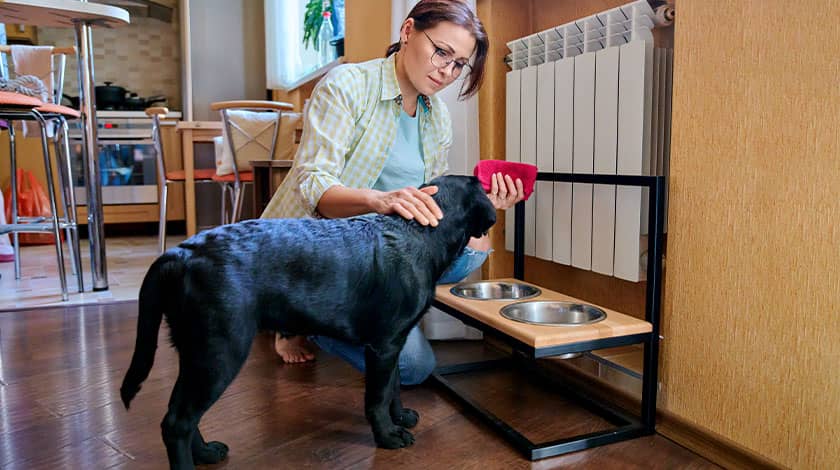Pet-Proofing Your New Home: A Guide for Pet Owners

Moving into a new home is an exciting time for the whole family, and that includes our furry friends too! But, just like child-proofing is essential for toddlers, pet-proofing is a necessary step for our four-legged family members. Pet-proofing your home is essential to ensure their well-being and to prevent any accidents or damage. In this guide, we'll provide you with some valuable tips on how to pet-proof your new home effectively.
Why is Pet-Proofing Essential?
Pet-proofing is essentially the art of modifying your home environment to ensure it's a safe sanctuary for your pets. This process requires a proactive approach in preventing your pets access to harmful substances, reinforcing potentially hazardous areas, and providing them a safe space to explore, grow, and play.
In a home that hasn't been pet-proofed, even the most mundane items and spaces can turn into potential hazards. The risks can range from unsecured trash cans, loose wires, to specific household plants - any of which could become a menace for an unwary pet.
Understanding your pet's individual needs and behaviors plays a critical role in effective pet-proofing. For instance, a playful kitten may have a penchant for scaling lofty spaces, while a teething puppy could make a chew toy out of anything within reach. Other pets like birds, rodents, and reptiles also have their unique needs and characteristics. Being cognizant of these behavioral traits and preferences is the key to creating a pet-friendly environment in your home.
Also read: Essential Pet Registration Tips for Pet Owners When Moving
Room by Room Guide to Pet-Proofing
1. Assess Potential Hazards
Start by inspecting your home from your pet's perspective. Get down on all fours and identify any potential hazards that could pose a threat to your furry friend. Look out for loose wires, toxic plants, small objects that can be swallowed, or cleaning supplies that are within reach.
Keep in mind that pets are naturally curious, so take the necessary precautions to eliminate or secure these hazards.
Note: Make considerations based on your pet's age and health. Puppies and kittens are bundles of energy that need special extra care, while older pets might require more rest and cause less chaos.
2. Secure Dangerous Areas
Certain areas of your home may be off-limits to your pet for their safety. Identify rooms or spaces where your pet could get into trouble, such as the garage, laundry room, or any area with hazardous substances. Here are some useful pet-proofing ideas for each room:
- Kitchen: Store food items and sharp utensils out of reach. Make sure trash cans have lids, and appliances are secure.
- Living Room: Protect furniture with covers, secure loose objects and cables. Consider pet-friendly decor.
- Bathroom: Keep toilet lids closed, store cleaning agents and medications safely, and ensure the floor is slip-proof.
- Bedrooms: Keep clothes, especially small items like socks and shoes, out of reach. Ensure windows are secure.
- Garage and Basement: Store all harmful substances, sharp tools, and heavy equipment securely. Limit pet access to these areas.
- Open Outdoor Spaces: Secure fences and gates, be aware of toxic plants, and make sure pools are covered when not in use.
3. Keep Trash and Recycling Bins Secure
Pets are notorious for getting into trash bins, which can contain harmful substances or pose a choking hazard. Use bins with secure lids or store them in a cabinet to prevent your pet from rummaging through them. Dispose of hazardous materials properly, such as cleaning products, batteries, and sharp objects.
4. Avoid Window Hazards
Pets are naturally curious and may be attracted to windows, especially if they can see birds or other animals outside. Ensure that windows are securely screened or use window barriers to prevent your pet from accidentally falling out. Avoid placing furniture near windows that your pet could climb on, as they may accidentally knock items over or cause damage.
5. Securely Store Food and Pet Supplies
Store pet food, treats, and supplements in sealed containers to prevent your pet from accessing them. Some pets have a knack for opening cabinets or containers, so choose options that are pet-proof or use childproof locks. This will not only prevent overeating but also protect your pet from ingesting something harmful.
6. Be Cautious with Open Flames
Pets can accidentally knock over candles, oil burners, or other open flame sources, resulting in burns or fires. Opt for flameless candles or use enclosed holders that are out of your pet's reach. Never leave open flames unattended, and extinguish them before leaving the room.
7. Anchor Furniture and Appliances
Large furniture pieces, such as bookshelves, dressers, or TVs, can tip over if your pet jumps or climbs on them. Secure these items to the wall using anchors or braces to prevent accidents. This is especially important for households with active pets or curious kittens who love to explore their surroundings.
8. Provide Adequate Mental and Physical Stimulation
Pets need mental and physical stimulation to prevent boredom and destructive behavior. Ensure they have access to toys, scratching posts, and interactive puzzles to keep them engaged. Regular exercise and playtime are crucial for their overall well-being, so dedicate time each day for activities that meet their energy levels and interests.
9. Store Medications and Chemicals Properly
Pets are often attracted to the smell and taste of medications and chemicals, which can be harmful or even fatal if ingested. Ensure that all medications, cleaning products, and chemicals are stored in secure cabinets or high shelves, out of your pet's reach.
10. Choose Pet-Friendly Plants
Some plants can be toxic to pets if ingested. Research and choose pet-friendly plants to decorate your home. Avoid plants such as lilies, azaleas, etc., as they can be poisonous to cats and dogs. Instead, opt for pet-safe plants like spider plants, Boston ferns, or African violets, which are non-toxic and add a touch of greenery to your space.
11. Secure Electrical Cords and Wires
Pets, especially puppies and kittens, love to chew on things, including electrical cords and wires. Not only can this lead to damage to your electronics, but it can also be dangerous for your pet. Secure cords and wires using cord covers or by taping them to the baseboards to prevent access and potential electrical hazards.
12. Install Secure Fencing and Check for Escaping Points
If you have a yard or outdoor space, ensure it's properly fenced and secure. Check for any gaps or holes where your pet could escape and make the necessary repairs. A secure outdoor area will allow your pet to enjoy the outdoors safely and provide them with exercise and mental stimulation.
13. Create a Pet-Friendly Space
Designate a specific area in your home where your pet can feel safe and comfortable. Set up their bed, toys, and a few essential items in this space. Make sure it's easily accessible to them and that they have access to fresh water and a litter box (if applicable). Providing a designated space will help them feel secure and minimize any potential destructive behavior.
14. Be Mindful of Small Objects
Keep small objects, such as children's toys, jewelry, or craft supplies, out of your pet's reach. Swallowing small objects can lead to choking or intestinal blockages, requiring emergency medical attention. Regularly scan your home for any potential hazards and promptly remove them to ensure your pet's safety.
Conclusion
A pet-proof home is a safe haven for your pets. It takes time and effort, but the peace of mind it brings is worth every bit of it. After all, our pets deserve a safe and secure home, just like the rest of the family.
By assessing potential hazards, securing dangerous areas, storing medications and chemicals properly, choosing pet-friendly plants, creating a pet-friendly space, etc., you'll create a safe and comfortable environment for your pet. Keep in mind that each pet is different and may have different needs, and that pet-proofing is an ongoing process. As your pet gets bigger or acts differently, you should check your home for any new dangers.
By following these pet-proofing tips, you'll be well on your way to providing a secure and loving environment when moving with your pets to your new home. Enjoy the journey of pet ownership and cherish the moments you spend together in your safe haven!











